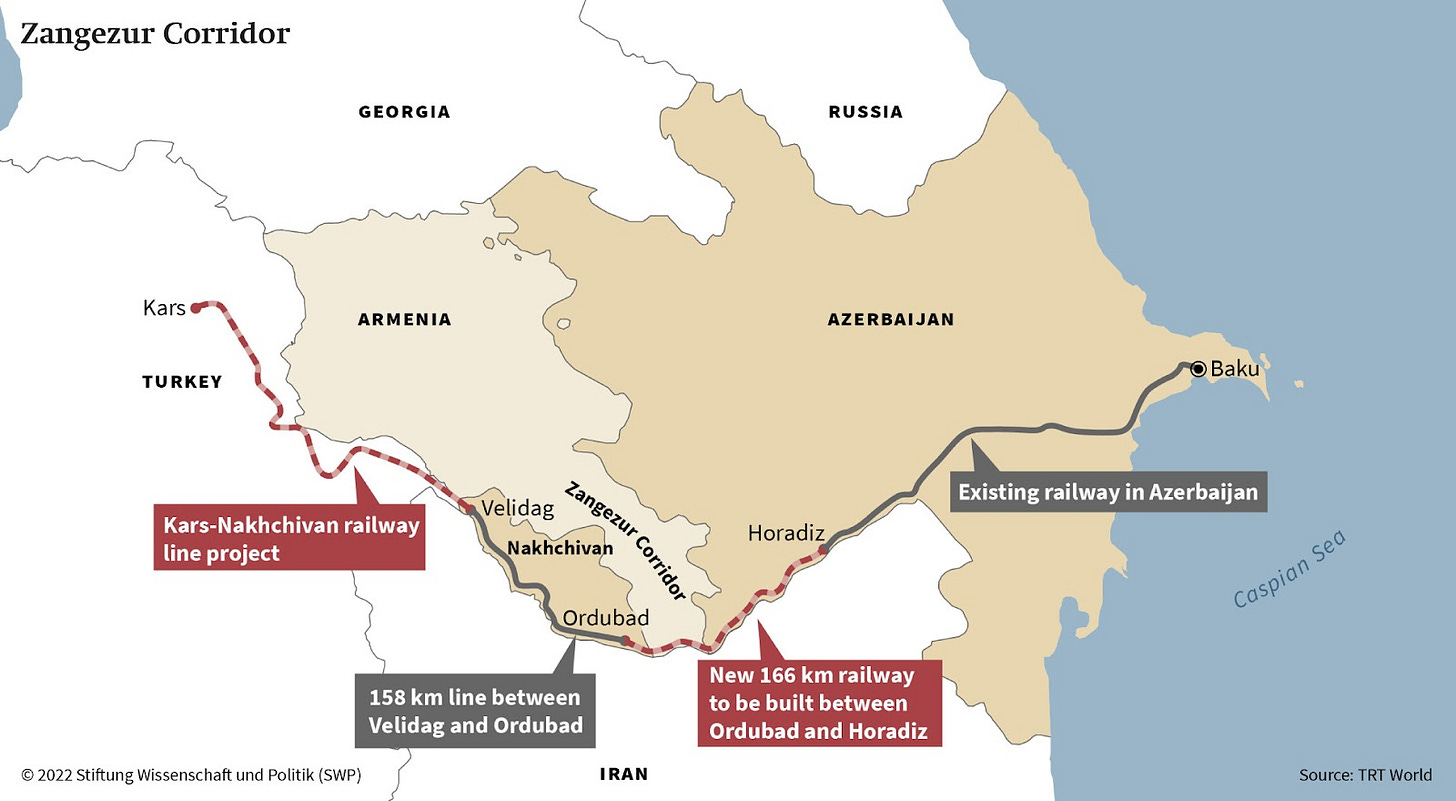Trump’s Armenia–Azerbaijan Peace Gamble
A 27-mile strip of Armenian territory may redefine the balance between Russia, Iran, and the West
This past Friday in Washington, D.C., the South Lawn of the White House became an unlikely venue for reconciliation. Armenian Prime Minister Nikol Pashinyan and Azerbaijani President Ilham Aliyev, adversaries for more than three decades, signed a peace agreement brokered by President Donald Trump.
For most Americans busy with the concerns of everyday life and far from the world of foreign policy, the conflict over Nagorno-Karabakh is either a far-off, complicated dispute or something they’ve never heard of at all. For policymakers in Washington, Brussels, and Ankara, the agreement represents a significant shift in regional dynamics. The deal carries far-reaching implications, promising opportunities for cooperation as well as new sources of tension. Beyond ending an entrenched dispute, it initiates a strategic infrastructure project with the potential to reconfigure trade routes, realign alliances, and place Western influence deeper into a region historically dominated by Russia and Iran.
At the center of the agreement is the Zangezur Corridor, a 27-mile stretch of southern Armenia. Under the deal, Armenia will lease the corridor to the United States for 99 years, and Washington will sublease it to a private consortium. The Trump Route for International Peace and Prosperity (TRIPP) will combine highways, rail lines, pipelines, and fiber-optic cables to connect Azerbaijan to its Nakhchivan exclave, Turkey, and onward to European and NATO markets.
Though billed as a commercial project, the corridor has strategic importance. It skirts both Russia and Iran, forges a direct link between the South Caucasus and Western markets, and, for the first time, positions U.S.-aligned figures—whether in government or the private sector—along Iran’s northern frontier.
The Armenia–Azerbaijan rivalry dates back to the early 20th century and escalated during the final years of the Soviet Union. Nagorno-Karabakh, a majority-Armenian enclave within Azerbaijan, became the focal point of two wars that left tens of thousands dead and displaced. Moscow dominated mediation efforts for decades, mainly through the OSCE Minsk Group, using the process to maintain leverage over both capitals.
Russia’s war in Ukraine, combined with its diminished regional standing, made this possible. Trump approached the negotiations in line with his transactional style, framing peace as a shared economic opportunity. Aliyev, attuned to pragmatic deals, was willing to explore the proposal. Pashinyan, increasingly disillusioned with Russia’s security commitments, calculated that a Western-brokered agreement might deliver better results. Putin unwittingly opened the door, and Trump walked right through it.
Zangezur has been a strategic hinge between the Caspian and Black Sea basins for a long time. Under TRIPP, Armenian sovereignty over the land is maintained, but development and management will fall to a U.S.-backed consortium. The project envisions:
A four-lane highway linking Baku to Kars in Turkey
A parallel railway
Pipelines for oil and gas transit
Fiber-optic cables, with potential for high-voltage transmission lines
The move promises major economic ripple effects. Azerbaijan would gain a secure and direct link to Turkey and European markets and strengthen its role as an energy supplier to the West. Armenia would gain diversified trade routes and reduce economic dependence on Russia. For Turkey, the corridor fulfills a long-sought-after direct land connection to Azerbaijan and Central Asia’s Turkic states.
European stakeholders see an opportunity to bolster energy security in the post-Ukraine landscape, with Caspian gas moving through NATO territory rather than Russian-controlled routes.
The agreement indicates a deliberate move by both Armenia and Azerbaijan to expand ties with the West. Armenia has already suspended participation in the Russia-led Collective Security Treaty Organization (CSTO) and is now hosting a U.S.-facilitated project of significant scope. Azerbaijan continues to maintain working relations with Moscow but is deepening links with NATO members, particularly Turkey and the United States.
For Russia, the development is a setback. It loses both mediation authority and the prospect of overseeing a key transit route. The Kremlin’s subdued response reflects its reduced influence.
Iran regards its border with Armenia as one of its few overland connections to Eurasia not under the control of adversaries. The corridor’s alignment cuts Tehran out of a northward trade route to Russia and introduces U.S.-aligned infrastructure on its doorstep. Iranian officials are not happy, to say the least, and have threatened to turn the area into "a graveyard of the mercenaries of Donald Trump.” They have voiced concern that the project could be leveraged to limit trade and expand Western intelligence capabilities in the region. State media have described the agreement as a “Western infiltration plan,” though Tehran’s options for direct counteraction are limited.
Supreme Leader Ali Khamenei characterized the agreement to build the Zangezur corridor as “a great betrayal” and cautioned that it “must not go unanswered” by the Islamic Republic.
Iran International reported that on Sunday, The Daily wrote: “Iran should use the levers at its disposal to confront them and, as a first step, can invoke the Geneva and Jamaica conventions to ban the passage of US- and Israeli-affiliated vessels through the Strait of Hormuz.” What Iran can and will follow through on is unclear.
Outside the Caucasus, TRIPP has the potential to link NATO infrastructure directly to Central Asia. Rail and road routes from Turkey through Azerbaijan and across the Caspian Sea to Kazakhstan would create an alternative to China’s Belt and Road network. The region’s reserves of hydrocarbons, rare earth metals, and uranium make it highly valuable for Western economies seeking secure supply chains.
The U.S. government has stated (and the agreement prohibits) that it will not station combat forces along the corridor. However, the involvement of an American-led venture suggests private security contractors will operate there. Many are likely to have prior military backgrounds, effectively placing U.S.-aligned personnel close to Iranian territory without establishing a formal base.
Such arrangements allow Washington to maintain a presence, secure the route, and monitor regional developments at relatively low cost.
Europe gains a more secure energy corridor. The United States extends its strategic reach into a region where it has traditionally had a limited footprint. Turkey strengthens its role as a trans-Eurasian connector. Armenia and Azerbaijan open new economic channels while reducing their reliance on Moscow.
In Armenia, some critics argue the lease could set a precedent that undermines sovereignty. Unresolved humanitarian and political issues—such as the status of displaced Armenians from Nagorno-Karabakh, the release of detainees, and cultural site protections—are contentious. There is also concern about the corridor becoming a target for sabotage, particularly from actors aligned with Iran or other states opposed to the project.
If TRIPP is successfully implemented, it would integrate the South Caucasus into Western economic and security structures in a way not seen since the collapse of the Soviet Union. The corridor would alter regional trade flows, reduce the geopolitical leverage of Russia and Iran, and create new pathways for cooperation between NATO members and Central Asian states.
Infrastructure alone cannot resolve the underlying political and ethnic disputes of the region, but the agreement demonstrates how strategic connectivity projects can influence long-term alignments. Whether the Zangezur Corridor becomes a lasting success will depend on sustained political will, effective management, and the ability to navigate the geopolitical frictions it is sure to provoke.
Middle East Uncovered is powered by Ideas Beyond Borders. The views expressed in Middle East Uncovered are those of the authors and do not necessarily reflect the views of Ideas Beyond Borders.




I wonder how this will play out in the Armenian legislature since it still requires approval there. Potential consequences to opposition scuttling the treaty. Also would be interesting to know if Armenian officials have lobbied for a security guarantee from the US, if that was ever a possibility..
I'm beginning to see a pattern with Trump: Make business deals, not war. A business deal was also involved with the peace agreement between Thailand and Cambodia. This is definitely a new approach and it seems very positive. Thanks for this contribution. These areas, as you point out, are off most Americans radar, but apparently not Trump's. I appreciate The Middle East Uncovered for coverage that's hard to find elsewhere but IMPORTANT.